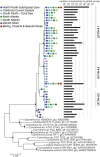Symbiotic unicellular cyanobacteria fix nitrogen in the Arctic Ocean
- PMID: 30538206
- PMCID: PMC6310837
- DOI: 10.1073/pnas.1813658115
Symbiotic unicellular cyanobacteria fix nitrogen in the Arctic Ocean
Abstract
Biological dinitrogen (N2) fixation is an important source of nitrogen (N) in low-latitude open oceans. The unusual N2-fixing unicellular cyanobacteria (UCYN-A)/haptophyte symbiosis has been found in an increasing number of unexpected environments, including northern waters of the Danish Straight and Bering and Chukchi Seas. We used nanoscale secondary ion mass spectrometry (nanoSIMS) to measure 15N2 uptake into UCYN-A/haptophyte symbiosis and found that UCYN-A strains identical to low-latitude strains are fixing N2 in the Bering and Chukchi Seas, at rates comparable to subtropical waters. These results show definitively that cyanobacterial N2 fixation is not constrained to subtropical waters, challenging paradigms and models of global N2 fixation. The Arctic is particularly sensitive to climate change, and N2 fixation may increase in Arctic waters under future climate scenarios.
Keywords: Arctic; cyanobacteria; marine microbiology; nanoSIMS; nitrogen fixation.
Copyright © 2018 the Author(s). Published by PNAS.
Conflict of interest statement
The authors declare no conflict of interest.
Figures




References
-
- Falkowski PG, Barber RT, Smetacek V. Biogeochemical controls and feedbacks on ocean primary production. Science. 1998;281:200–207. - PubMed
-
- Breitbarth E, Oschlies A, LaRoche J. Physiological constraints on the global distribution of Trichodesmium–Effect of temperature on diazotrophy. Biogeosciences. 2007;4:53–61.
-
- Tyrrell T. The relative influences of nitrogen and phosphorus on oceanic primary production. Nature. 1999;400:525–531.
-
- Thompson AW, et al. Unicellular cyanobacterium symbiotic with a single-celled eukaryotic alga. Science. 2012;337:1546–1550. - PubMed
-
- Tripp HJ, et al. Metabolic streamlining in an open-ocean nitrogen-fixing cyanobacterium. Nature. 2010;464:90–94. - PubMed

